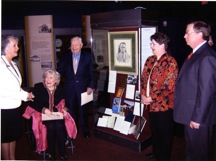Higher Education Exhibit
- Home
- Higher Education Institutions
- Exhibit
In 2005 the Oklahoma History Center—the new home of the Oklahoma Historical Society— and OHEHS opened in Oklahoma City. Partnering with the Oklahoma Historical Society and working in conjunction with the museum staff, the Oklahoma Higher Education Heritage Society helped develop the higher education exhibit.
OHEHS supports and maintains the higher education exhibit. On a rotating basis, the exhibit tells the story of the institutions and systems of higher education in Oklahoma. Much of the material displayed in the exhibit comes from donations made to the archive of Oklahoma Higher Education, a collaborative project between OHEHS, the Oklahoma Historical Society, and the State Regents for Higher Education. These donations come from various institutions throughout the state and from individuals. The higher education exhibit is a special area within the larger education exhibit, located in the Noble Foundation Gallery on the third floor of the History Center.
 From left to right: Sue Bennett, Frances Bennett, Tom Bennett (son), Elizabeth Bennett, Tom Bennett, Jr.
From left to right: Sue Bennett, Frances Bennett, Tom Bennett (son), Elizabeth Bennett, Tom Bennett, Jr.Photograph by Paul Bass
In March of 2007, OHEHS acquired through donation articles from the personal collection of Dr. Henry Garland Bennett, former [resident of both Southeastern Oklahoma State University and Oklahoma A&M College (Oklahoma State University), and director of the Point Four Program under President Harry S. Truman. Included in the Bennett Collection are a portrait by artist L. Pendleton; Bennett's doctoral dissertation, Vera Bennett's diary from Bennett's Point Four trip to South America, letters of appointment, photographs, and personal letters.
Developed by the OHEHS archivist and with installation services by the museum staff, the Bennett exhibit opened on April 13, 2007, at the History Center. While the higher education exhibit is dedicated to telling the story of institutions, Dr. Bennett's contributions were so great and far-reaching to warrant a special exhibit dedicated to one individual, most likely the only higher education exhibit to do so.
Dr. Henry Garland Bennett (1902–1951) served as president of Southeastern State Normal School (Southeastern Oklahoma State University) from 1919 to1928. While president of Southeastern, he changed the school name to Southeastern State Teacher's College, made it a four-year college, the first in the state to conduct year-round classes, and instituted numerous courses of study. From 1928 to 1951 Bennett served as President of Oklahoma A&M College (Oklahoma State University). During his tenure, Bennett introduced his "25 Year Plan" of campus expansion, started a doctoral program, established through A&M the first Soil Conservation Station (which led to the establishment of the National Soil Conservation System), helped begin the Flying Farmers Association, established a number of colleges, including the School of Veterinary Medicine and the nation's first fire service academic program at Stillwater. He also started an academic program for WAVES, "Vet Villages," and the Oklahoma Power and Propulsion lab. Bennett earned his Ph.D. from Columbia and his dissertation, "The Coordination of the State Institutions for Higher Education in Oklahoma," guided the formation of the state system of higher education.
Bennett believed in the betterment of all people through education and self-determination. Dr. Bennett's contributions to the state garnered national attention. In 1945, Bennett was appointed to the Quebec International Food and Agricultural Organization where he proposed a plan for revitalization for underdeveloped countries. This work would later lead to his appointment by President Harry Truman as head of the International Point Four Program. In 1948 Bennett served as Oklahoma's representative to the Interim Council on Regional Planning in Higher Education for the Southern Governors Conference to discuss equality in higher education. In 1949 Bennett accepted an 8-week assignment to the German "Trizonia," an area ravaged during WWII. In 1949 and 1950, Bennett toured underdeveloped countries in the Middle East, India, Japan, and South America. He was invited to lend assistance to Ethiopia by then Emporer, Haile Selassie. In 1950 Bennett was appointed the Director of the Point Four Program. During a 1951 tour of Europe and the Middle East, Bennett, his wife, Vera, and members of the Point Four Program were killed in a plane crash. His impact on the world community is immeasurable. Bennett was truly a "dreamer of no little dreams." In 2007, author Paul Bass published the first biography of Henry Bennett titled, No Little Dreams: Henry Garland Bennett, Educator and Statesman.